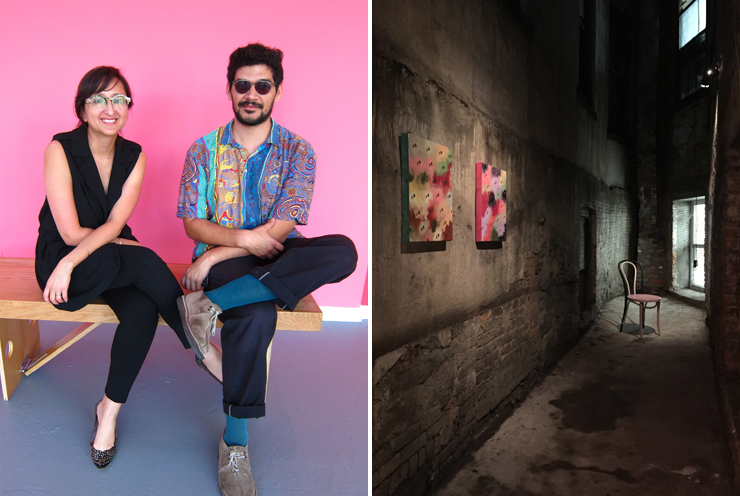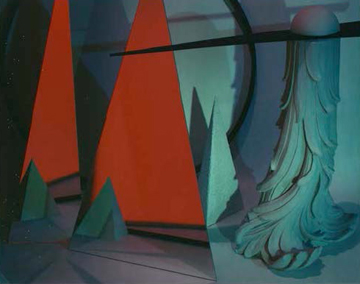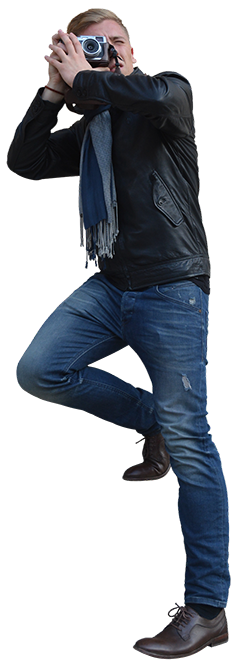
LEFT: ACSF Artistic Director Natalia Zuluaga and co-curator Domingo Castillo. Photograph by Irene Sperber. RIGHT: Alan Gutierrez, "Don't tell someone that you like how they are doing something because they may stop to thank you", Installation shot. image provided by ArtCenter South Florida.
For 30 years ArtCenter South Florida has stood by, documenting the many moods and metamorphoses of Miami from its perch on Lincoln Road. ACSF ceded their large iconic corner space in 2014 but maintain a reliable hold over the turf with their catbird seat from the second floor of 924 Lincoln Road.
ACSF’s latest exhibition is appropriately titled An Image, a pithy coining of phrase denoting a long and winding tale of history and change in Miami’s reputation, both personal and around the world. Flashy, attractive and easy to sell, our subtropical enclave has mesmerized many a PR firm with its possibilities. Reality and myth mesh into one as we untangle the threads of transformation.
The inspiration for this exhibition is the iconic Miami Shores Pink House by award winning Miami based (and now global) architectural firm Arquitectonica, manned by the glossy couple Laurinda Spear and Bernardo Fort-Brescia. Built for Spears parents between 1976 and 1979, this symbolic edifice paved the way for the Atlantis condo (again by Arquitectonica) featured in the game changing "Miami Vice" TV program (1984-1990). And off we went into another high flying moment in Miami’s universe grabbing imagery. This show’s title, "An Image," is taken from Harun Farocki’s 1988 German documentary film dealing with the trappings of a lifestyle, presenting a critical perspective of the making of an image.
I sat down with ACSF new Artistic Director Natalia Zuluaga along with artist and guest curator for "An Image," Domingo Castillo. I wanted to get a handle on the Center’s focus for the next generation. (Castillo also co-runs the space in Little Haiti called Noguchi Breton.)
“I am part of a larger revisioning project for the ArtCenter that has been going on for some time," said Zuluaga. “There will be new residency programs, a new fellowship program, exhibition models that will be longer in duration with more public programs, and an important pedagogy platform that we developed for artistic research.”
“We are synthesizing our mission.” clarified Zuluaga.

LEFT: Aquitectonica's Laurinda Spear and Bernardo Fort-Brecia, "Pink House". Photograph by Eric Meola. RIGHT: Harun Farocki, "An Image", 16mm film transferred to video. image provided by ArtCenter South Florida.
They are also expanding current studio programs and supporting artists, curators and writers, fostering their development with projects and their own practices, while providing Miami with lectures, screenings and performances that “cross cut with some of our concerns with contemporary society.”
We segued into discussion about the role Lincoln Road has played with the ArtCenter over the decades.
“The way in which the Road has changed in the past 30 years, it’s something to reflect upon. Even our relationship to the city and relationship to open public spaces. Being situated here also gives us a first hand account about what is our relationship with consumer culture. Instead of just being patrons or a site, we want to critically engage with our surroundings," said Zuluaga.
Domingo Castillo added: “If you're here why not talk about what’s happening. Just the weird history of how the Road has morphed, with the art center being here and helping artists the entire time, and helping other institutions.”
“Buying a site so early on and planting roots here allows for this kind of engagement to happen to this place.”
Zuluaga continued: “Choosing to be on this particular strip, it means we’re also inside of it and open to the same questions of the attention economy; all these shops, and all of these people and art walks….. we’re very much a part of the crawl that went through the strip. We are not completely removed from it, but I like to think we have a little bit of critical awareness that gives us a place to depart with our program.”
Zuluaga got to the core of the exhibition’s inspiration, “The image becomes the basis for the new systems of value, whether it’s cultural value, economic value, body value . The exhibition is trying to ask what is our contemporary relationship to images…how do images function and create reality.”
“(It) grew from a question about what images do here…..”
DC: “and how people abuse them throughout history here.”
NZ: “…The architectural rendering versus real estate speculation…..

Barbara Kasten,"Construct NYC 19", Polacolor photograph. image provided by ArtCenter South Florida.
DC: “Even a hundred years back, how Coral Gables was sold to the rest of the country. There were beautiful water colors and pencil and line drawings of this exotic riviera of the south; but everyone got here and it wasn’t quite that, but it still has that wave that it wanted.”
Castillo got involved from square one. He and Zuluaga have know each other for over 10 years, talking about this very subject for as long. Zuluaga grew up on Miami Beach and met Castillo printing in a photo lab at FIU. They began intense discussions on the possible political power of the positioning of the image. They continued the conversation into grad school and have been oft collaborators ever since. Castillo, as an artist and curator, was a natural choice to bring this topic to Miami public discourse.
NZ: “Because we always conceived this never as a closed exhibition, we always thought what was important, and this gallery would also mimic those processies and would create an image. So it helped to recalibrate the way in which we think about this space. That was objective A. To really address the image, we couldn’t do it in an exhibition space, that would mean we’re importing images instead of creating them. We always felt that this was an exhibition created by public programs and objects. The public programs is the other heart of the exhibition.
DC: “It was long form public programs. Even the programs are part of the entire logic of the exhibition.”
NZ: “ There’s a clarity in how the objects contribute to this process and how public programs really open up these questions.”
“We want to use this as a platform to talk about it further, like in lectures, public screenings and the politics of the image.”
DC: “It’s a very Miami Beach topic. Working with other institutions, everyone is playing into these systems….. for good reason.”
“We’re doing a Wall Cast screening at New World Symphony, Nov. 20.” (showing videos and animation)
They want to be a conduit to the rest of the city.
DC: “All these institutions started small and have grown, it’s a way for everyone to keep working together.”
NZ: “There needs to be a mutual understanding that we are part of the same cultural community. Success does not happen alone.”
What is on view, you may ask. There are eight “moments” (and I quote) in the show, nine including the exhibition design. As I strolled in, a selection of five gloriously pink wall hues became the first impression, bringing us to the springboard of this presentation: Arquitectonica’s the Pink House.
NZ: “The argument we were trying to make with the house is it recalibrated the image of Miami.” “Arquitectonica set them selves up to represent the new Miami style and changed the landscape in the process.”
Every layer of the house is a different shade of pink, all carefully color matched in the gallery by Zuluaga and Castillo.
DC: “The house was built as a stage to make images out of and became an image making machine. All their houses after have a heavy image quality.”
NZ: “It’s a very keen, very advanced usage of the image.”
Zuluaga broke down the basics of what I was to see as I perused the ArtCenter gallery space.: “A lot of these pieces have to do with the actually construction and assembly of an image.”
Other artwork:
- Enrique Castro-Cid: a multiverse of realities through painting (Fun Fact: he worked with CAD program from Mt Sinai back in ‘80s)
- Alan Gutierrez: installation shots utilizing theatrical lighting
- Barbara Kasten: Constructs 1-2, polacolor photographs
- The sound track for the exhibition is by Heinrich Mueller from the techno group, Drexciya, a visual cosmology (Dataphysix Renormalon)
- Human Learning: an algorithm that records and interprets reading group sessions
- Susan Pitt’s animation, Asparagus (1979), completely hand drawn, with claymation.
DC: “Miami is so heavy with understanding images. It was built after the camera, it is the city of image, L.A. is the city of the moving image and Las Vegas is the city of the mirage.”
“You come here because of the image.”
When you visit: slow down and take the time to understand and open a new dialogue. Read the information, talk to the gallerists and take away a greater understanding of what is right in front of you and the guts and gears of our chosen world.
"An Image" exhibition runs now through Dec. 18:
Hours: 11 a.m.. to 7 p.m., Monday through Friday, 8 p.m. Saturday and Sunday.
ArtCenter South Florida
924 Lincoln Rd #205, Miami Beach, 33139
www.artcentersf.org
Other offerings by ACSF:
- Residency Program
- Facebook Page: Keep up on all the lectures, screenings, workshops, exhibitions and exciting upcoming partnership eventson their
- Bruce High Quality Foundation (BHQF)
- Soon partnering with Brooklyn’s art collective
- Teen Art Study Program
- Public Program
“The ocean is a central image. It is the symbolism of a great journey.” -- Enya
 MAIN MENU
MAIN MENU

